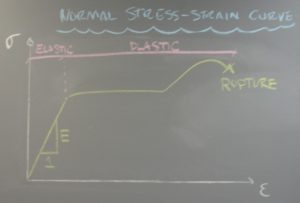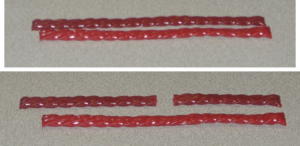Model Description
This is a simple demonstration of the basic principles underlying the elastic and plastic behavior of materials subjected to an axial load. The demonstration can also be used to show the highlight the elastic and plastic portions of stress-strain curves. This demonstration should take 8-10 minutes.
Engineering Principle
The basic definitions for stress, deformation, and strain:
(stress)
(deformation)
(strain)
where the stress is force over area, axial (longitudinal) deformation is equal to the final length minus the initial length. The longitudinal strain is equal to the axial deformation divide by the initial length. Further, according to Hooke’s Law, a stress-strain curve for each material can be developed showing elastic and plastic behavior.
Hooke’s Law:
where the Modulus of Elasticity (Young’s Modulus) is equal to the normal stress divided by the longitudinal strain. Further, in the Elastic Region of the stress-strain curve, a material will return to its original shape while in the Plastic Region permanent deformation is induced. The material finally ruptures and breaks.
What You Need
| Item | Quantity | Description/Clarification |
|---|---|---|
| Twizzlers | varies | Each student will need two Twizzlers, one control and one experimental. |
How It’s Done
Before Class: Purchase enough Twizzlers so that each student and the instructor will have two. It also helps to open the package before hand to speed up the process.
In Class: During the lesson, the stress-strain curve is drawn and the various regions on the curve are identified (Elastic, Yielding, Inelastic/Plastic, and Fracture) (figure below). Then bring out the Twizzlers to allow the students to make real-world observations about these various material behaviors.

Each student will have one Twizzler as a control and the other will be used for the experiment. First, have the students pull on the experimental Twizzler with a small amount of force and notice how it will go back to its original length as compared to the control Twizzler (the Elastic Region). Next, have the students pull on the Twizzler more, just enough to induce permanent deformation so that it remains longer than the reference Twizzler, but not enough to break it (figure below, top). Plastic behavior! Finally, have them pull on the Twizzler with enough force to cause it to rupture (figure below, bottom)!

Observations: Point out the difference between deformation/strain in the elastic region (the Twizzler returns to its original length every time) and plastic region (permanent deformation).
After using the Twizzlers for the demo, destroy the evidence by eating the training aids!
